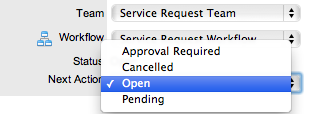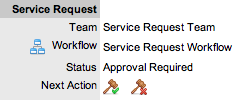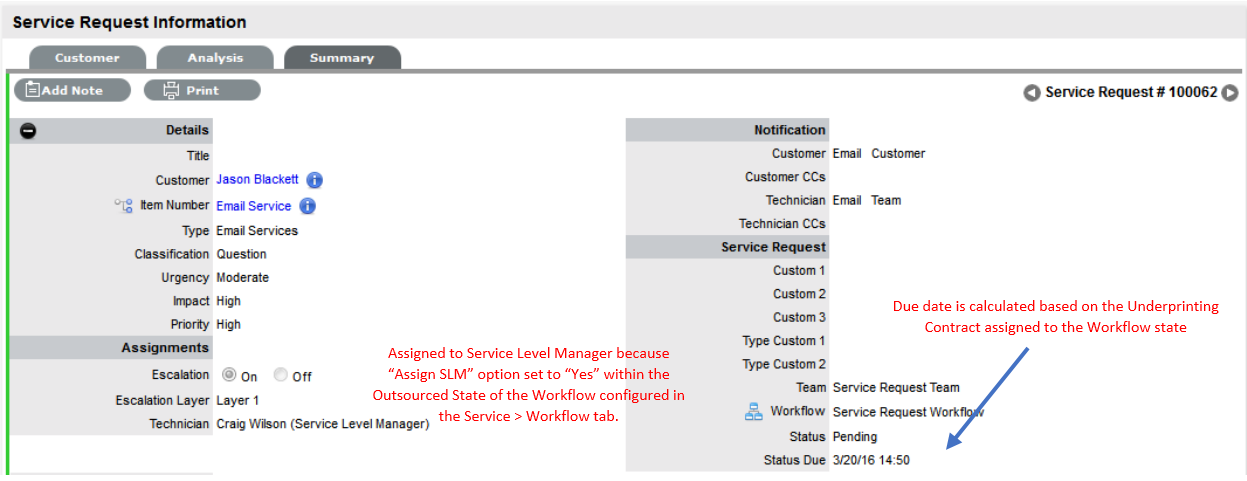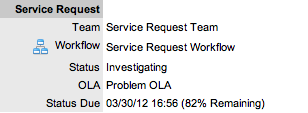 . The Workflow map displays the entry points (blue
boxes), transitional States (yellow boxes) and exit points (red boxes).
. The Workflow map displays the entry points (blue
boxes), transitional States (yellow boxes) and exit points (red boxes).When a Service Request is created it is assigned a Workflow that governs the lifecycle of the Request. The SLA allocated to the Request determines the Workflow options made available for the Request. Before saving the Request, the User can adjust the system assigned Workflow, if more than one Workflow option is available.
After the Workflow is assigned
to the Request, all stages of the assigned Workflow can be viewed by selecting
 . The Workflow map displays the entry points (blue
boxes), transitional States (yellow boxes) and exit points (red boxes).
. The Workflow map displays the entry points (blue
boxes), transitional States (yellow boxes) and exit points (red boxes).
The User moves the Request through the Workflow Lifecycle by adjusting the options displayed in the Next Action field.
To move a Service Request through the stages of the Workflow, in the Summary tab of the Service Request Information screen:
Click Edit
The Next Action field with a drop down list of Status options is displayed
below the Status field.
Click on the Next Action field
The Status options are displayed. This list is based on the configuration
of the assigned Workflow.

Select a State
Click Save.
The selected Status is assigned to the Service Request with the updated
logic applied (i.e., the SLA Timers may now be active or inactive
based on the newly assigned State configuration or an alternative
Work or Manager Group may have been assigned to the Request. See:
Status.)
Approval States in Service Request Workflows provide the facility
to approve or reject Request activity to Manager Groups, Customers and
Line Managers. When a Request moves into an Approval State, the Edit button
is only visible to Manager Users within the Manager Group or the Team
Lead when the Request is in a Customer or Line Manager Approval State.
For Manager Approval States, Users who are not Managers within the Team,
can send a reminder to action a Request, by selecting ![]() .
.

Managers who are assigned a Request for approval can  (approve) or
(approve) or  (reject)
the Request, which automatically moves the Request to the next pre-configured
stage of the Workflow. Requests assigned a Customer or Line Manager Approval
State can be processed via the Customer Portal or email.
(reject)
the Request, which automatically moves the Request to the next pre-configured
stage of the Workflow. Requests assigned a Customer or Line Manager Approval
State can be processed via the Customer Portal or email.

Each State of a Workflow can be customized for either internal support contract management that is monitored by an OLA, or out-sourced to an external support provider, which is monitored by an Underpinning Contract.
When a Service Request moves into a State that is governed by an Underpinning Contract, for internal contract control the Service Request can be assigned to the Service Level Manager, if configured in the Workflow. This allows the Manager to maintain control of the Service Request, and to easily follow up with the external service provider, if required. The assigned SLM will be able to adjust the current Status, add Notes and update the Contract Monitor information in the Impact tab.

Alternatively, the Workflow State can be configured for the Technician assigned at the time the Request is moved to the Underpinning Contract State to maintain Request editing privileges and manage adherence to the assigned service agreement. If the Workflow is configured for the responsibility of the Request to be maintained by the Technician when the Request is in an external contract state the Technician will be able to adjust the current Status, add Notes and, if the Technician is assigned the Internal Process of Service Level Management amend the Contract Monitor information in the Impact tab.
Within the Summary screen, the Status Due field is visible when a Workflow status is monitored by an OLA. The time, date and percentage remaining information displayed is calculated using the OLA's Target Resolution time.

To ensure that all Requests are managed throughout the Workflow, the Team assigned to the Request when it is first logged within the system is set as the default Team. If a Request moves to a State that has an OLA assigned with a Team, the Request is re-assigned to that OLA's Team. When the Request moves out of the OLA State to a State where no OLA or Team is assigned, the Request is re-assigned to the default Team.
When the Contracts or Invoices functionality is enabled and a Request is created, the system will verify the service entitlement status of the Customer and if a valid contract is not in place, the new Request is assigned a Status of Pending-No Contract and locked until a valid contract is associated with the Request.
In a Request Group where the Customer and Organizational Unit does not have a Contract, if an Item applied to a Request has a Contract and another does not, a relevant Status will be applied to each Request. The User will be able to edit the Request with a valid Contract, but the Request without a Contract will be locked down to a Pending - No Contract Status, until a valid Contract is applied to the Request.

The Customer is automatically sent the NoContractCreateRequestSummary
email when the request is saved with the Status. A reminder email can
be sent by the Technician from within the Summary tab by clicking ![]() , when the Request maintains this Workflow Status assignment.
See: Contracts
, when the Request maintains this Workflow Status assignment.
See: Contracts